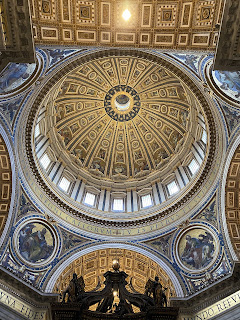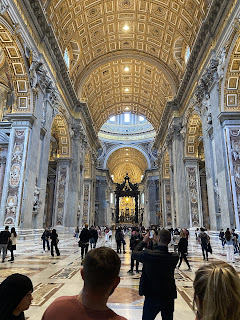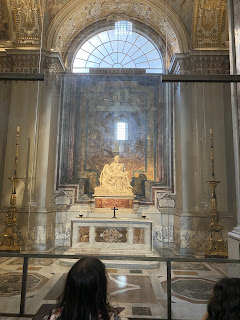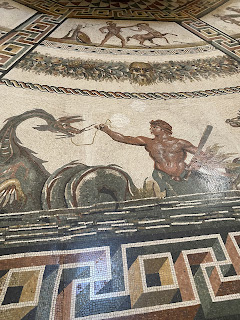Thursday was a marathon day. When I went online earlier in the week to purchase a ticket for the Borghese Museum I found out that they were only allowing 180 visitors into the museum per time slot and the only time available that whole week (with 3 spots left) was at 9:00am on Thursday, so I took it immediately! The Borghese Museum is a fantastic museum. Villa Borghese was the palace of Cardinal Scipione Borghese, the nephew of Pope Paul V. He was the patron of Bernini and a collector of paintings by Caravaggio, Titian, Raphael, Rubens, and Barocci, among others less notable. The lands surrounding the palace, known as the Borghese Gardens, and the palace itself was inherited by Prince Marcantonio Borghese who did extensive work to the gardens and reoriented much of the sculptures and paintings in the house to reflect the position of power that the Borghese family had in Rome. In 1808, Prince Camillo Borghese, Napoleon’s brother-in-law, was forced to sell the property and its collection to the Emperor, which saw several of the most important pieces moved to France - now in the Louvre. Thankfully, much of Bernini’s work remains at the Villa Borghese, which was sold to the Italian government in 1902 and made into a public, government run museum.
The Bernini Collection:
The flooring throughout the entire palace is inlaid marble of various colors - remarkable!
This is part of a panel that goes from floor to ceiling - there were at least six of them. They were created, not by painting them, but with tiny mosaic tiles no larger than your pinky’s fingernail.
There are so many additional pieces that were simply awesome. But here are just a few of my favorites. (I’ll make a rather harsh comment about this kind of wealth and collection when we get to the Vatican Museums, keeping in mind that this was the sole collection of one of the Holy Catholic Church’s Cardinals!)
Probably my favorite Caravaggio Painting. Pictured is an elderly St. Jerome at his writing desk with a skull on top of his pile of books.
I also like this painting of Jesus stomping on the head of a serpent, while Mary, his mother, holds him back. Watching and assessing the interaction is St. Anne, Mary’s mother. Most people during Caravaggio’s day did not like this painting, including the Cardinal himself as it depicted St Anne as an old, frail (and rather cadaverous looking) woman. What do you think?
I like this painting by Raphael with the vivid colors and the story it tells on the faces of those in attendance at Christ being carried to his burial site.
I love this painting of Jesus, Mary, and Joseph. I find it interesting that Fra’Bartolomeo painted Joseph in such shadows while he painted Mary completely in the light
And this painting by Raphael should probably be as celebrated as DaVinci’s Mona Lisa. It’s nearly the same in composition. In fact, I find it much more interesting. The background is barely even complete, while the details of her expression and those of the baby unicorn are beyond compare.
And finally, two dinner parties. One of the “Last Supper” and the other of a “Wedding in Cana”. What do you see in these paintings?
After visiting more of the collection, it was off to St Peter’s Square, the Basilica, and the Vatican Museums.
The Square itself is intimidating. It is huge with columns that surround half of it and a base that is concave, so that even if you are standing on the edges, you can see over the tops of those in front of you. There were very few people in the park, but still a long line into the Basilica.
St Peter’s Basilica is enormous.
To get an idea of the scale of this building - the letters of the words that are just below the ceiling are each 7 feet tall.
The Basilica can accommodate 70,000 standing worshippers within its walls.
And finally the most magnificent of all is Michelangelo’s Pieta, now behind a wall of glass after a madman came with a hammer and started destroying it:
Now, onto the Vatican Museums and the Sistine Chapel:
One of the first things you encounter upon entering is the outside veranda or porch with a Gigantic Pinecone on the front steps flanked by….yup…Peacocks! There are many interpretations with these pairing. After hearing several, here is mine: The pinecone is similar to the shape and look of the pineapple which has always represented “welcome”. Once open, spreads its many seeds on the forest floor which then wait for the proper conditions to sprout and spread - a sign of the many generations that are and will be shown/taught/experience the Good News of the Gospel. And the pairing of peacocks which I was told in Spain by my tour host that the peacocks have represented the idea of eternity from all different cultures/religions down through the years.

There isn’t any one piece of art that stands out from much of the others in the Vatican Museum. It’s all magnificent. And there is art from all different cultures, backgrounds, generations, and mediums. So, I won’t be pointing out any specific work of art until we get to the Sistine Chapel, Michelangelo’s crowning glory. But here are a few pieces to admire:
And finally, the Sistine Chapel. I only have two or three pictures of this room, as we were not allowed to take photos. I had already taken a couple before I was told not to take any. Sorry! We were allowed to take photos in other parts of the museum, I just assumed we could take them here.
The Sistine Chapel is both overwhelming and underwhelming at the same time. It’s overwhelming to see some of the favorite pieces of this ceiling like the Creation of Adam and the Last Judgement in person. To be surrounded by a piece of artwork that was created by one person, Michelangelo,
But underwhelming, too. Because the work, in all its glory, seems so small because there is just SO MUCH of it!
Ok, now my rather harsh comment. The power and wealth of the church and its leaders during this time period in history, as seen in modern retrospective eyes, is downright sinful. I now understand, even more fully, how some in the church rose up to rebel against it. It makes me nauseous to think of those who were forced into poverty as individuals and as societal throwaways because of the greed of people who learned about, taught, and were supposed to be following a different pathway. But, here is the greatest criticism of all. We haven’t changed one gosh darn thing!
I’m certainly glad that these pieces of magnificent art are available for all to see. I’m certainly thankful that these incredible artists of the past had benefactors and patrons that allowed them to express their creativity and skill. But, in their lifetimes, none of them were rich. They often did the work without pay! And today, when rich people (and especially Christians) get rich off the backs of the poor without using that wealth to help the poor in systemic ways, I’d call that a sin. The Bible speaks about this sin more than any other. Why? Because it is pervasive, universal, and the most damning. May some generation ahead of us, do better!
Ok, my sermon for the day.
I’m now in Sorrento, which is a resort sort of town along the coast of the Tyrrhenian Sea, just south of Naples and very close to Mount Vesuvius and Pompeii. I’m hoping to get a tour to Pompeii in the next couple of days and to have some great Southern Italian food.
Here’s some food I had in the last few days that was a bit more varied!
This pastry? was strange. I thought it would be a puff pastry with pastry cream. But it was more like a dinner roll with unsweetened cream or maybe whipped butter? I don’t know. I couldn’t eat it.












































































1 comment:
Have accessed this site twice; so much to see! Must do it one more time.
Post a Comment